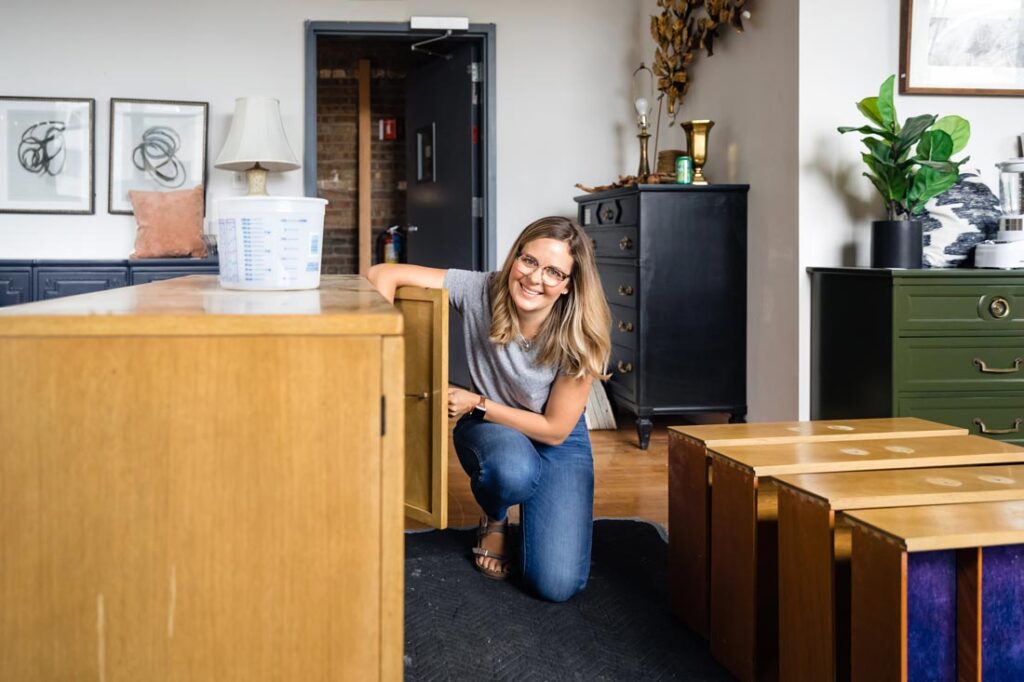One man’s trash is another man’s treasure—or in this case, one woman’s destiny. Nearly 12 years ago, Meg Piercy found a discarded dresser in an alley behind her Chicago home. She successfully refurbished it and sold it on Craigslist—a chance encounter that started her on a path to becoming the co-founder (along with her husband, Joe) and CEO of MegMade, a brand that’s become the gold standard in furniture restoration.
The business was just furniture at first, but over the past 12 years, MegMade has added more to its offerings. The Piercys now have a production facility, a warehouse and two storefronts, with more to come in the next year, and an estimated 20,000 restored furnishings under their belts.
The secrets to her success? Meg swears by these three rules:
- Don’t be jealous of somebody else’s overnight success.
- If there’s a problem, have an open-door policy and work through it together.
- Making money does not equal joy and fulfillment. (“Even when Joe and I had nothing, we had each other,” Piercy says.)
SUCCESS: I know about your origin story. But even before that, what did you and your husband do for a living?
Meg Piercy: My husband Joe opened a shoe store in the Chicago suburbs, and I worked for a not-for-profit called By The Hand, which helps kids in Chicago’s highest-risk neighborhoods. And then on the side, Joe was also flipping houses.
S: Let’s go back to the dresser that started it all—how did that happen?
MP: We were living on the North Side of Chicago, and we found the dresser in the alley behind our house. It was a yellow maple one with wood knobs. Our plan was just to sell it and use the money to buy a new one. So, we brought it inside and painted it. At that time, we didn’t feel like we even had the money to buy nice paint. So we bought one of those extra cans—a miscolored tint—from Home Depot and added plaster of Paris. We painted a stripe down the middle and added brass knobs. We put it on Craigslist, and literally in 12 minutes, we had an email saying, “I want to buy this.” We made $80.
S: Were you immediately hooked?
MP: Yes. We put a tarp in our living room, and we would watch TV while we painted. It was therapeutic. It was an escape. It was creative. We were using our hands. My mom always said, “Don’t turn your hobby into your profession. Keep it as a hobby.” But we took this hobby and turned it into a full-blown profession.
S: Surely you couldn’t find furniture in alleys every day. How did you source all of your pieces?
MP: We really did find good stuff in the alleys—like Baker, Henredon. Then, my husband became friends with the garbage men. He’d tell them to call him if they saw anything. I think he has 40 garbagemen in his phone as “(First Name) Garbage Man.” We also got to know local thrift shops and resale stores.
S: Chicago apartments are not exactly spacious. Where were you keeping inventory?
MP: We had one long hallway, and we could fit six dressers in it. People would come over to buy something, and Joe would say, “Meg made that. Meg made our dresser. Meg made our coffee table.” That’s where the name came from, and that’s what we called ourselves on Craigslist.
S: When did you pivot from working out of your home?
MP: When we were too big for our apartment, we rented our next door neighbor’s garage, and we started selling out of his garage. And this was still all done by hand. We hired some help: my cousin, along with students from the Moody Bible Institute. Then, we signed a lease for our first 700-square-foot store. We thought, “What if we can’t do this?” But we outgrew that store in six weeks.
S: At some point, you must have realized you needed to delegate. Was that hard?
MP: It was. But one of our mentors told me, “You need to be able to spend 80% of the time on your business and 20% in your business”—meaning I needed to be spending only 20% of my time painting and 80% on marketing. I like to get my hands dirty—much more than looking at Excel spreadsheets—but that’s not going to grow your business.
S: Did you have anyone try to buy the business out from under you?
MP: We did, but we never took on an investor. We’ve been scared to take on investors and that pressure of growing too fast. We have a small but mighty team. We pay our people well because we’re hiring people who are very capable.
S: Was your HGTV show Renovation Goldmine kind of similar to bringing on an investor?
MP: In a way, it was. We did eight one-hour episodes. It gave us so much more credibility than we already had. We might consider doing another show in the future, but we’ve realized that what we want to make is a legacy. We want to give something to our kids to grow. And it’s this business. It’s not a TV show.
S: Your initial business was simply finding something someone discarded and making it beautiful again. But now you do custom pieces. How much of each do you do?
MP: About 30% of what we do are the pieces someone already owns. We’ve rescued a lot of DIYs gone wrong. Or it might be something that looks really bad but means something to that client. People trust us to give something new life. But the majority of what we do is our own pieces [that we’ve found]—and it’s not just painting anymore. Our upholstery business is growing, our lighting business is growing, and we’ve moved into doing high-end lacquers. All of that has allowed us to switch from being focused on selling one piece at a time to selling whole rooms at a time. That has completely transformed our business. Our annual revenue is over $2 million. In just the last three months, we’ve doubled the previous year’s revenue for those three months.
S: How do you go about keeping that sense of purpose as successful as the business itself?
MP: We’re still just as passionate about the before and after. And our purpose is so much bigger than MegMade. We really use what we make here, and we give so much of it away to help other organizations that are doing worthy work.
S: With a husband-wife business and three sons at home, how do you both leave work at work?
MP: Our system is to get home in the evening, have dinner, spend time together, put the kids to bed at 8 p.m.—and then we can go back to work. Those are protected hours. Our kids only have one childhood, so we’re not going to mess it up. My mom always told me, “It’s easier to raise a good man than to fix a broken one.”
This article originally appeared in the November/December issue of SUCCESS magazine. Photo by ©JGP/Courtesy of MegMade.










